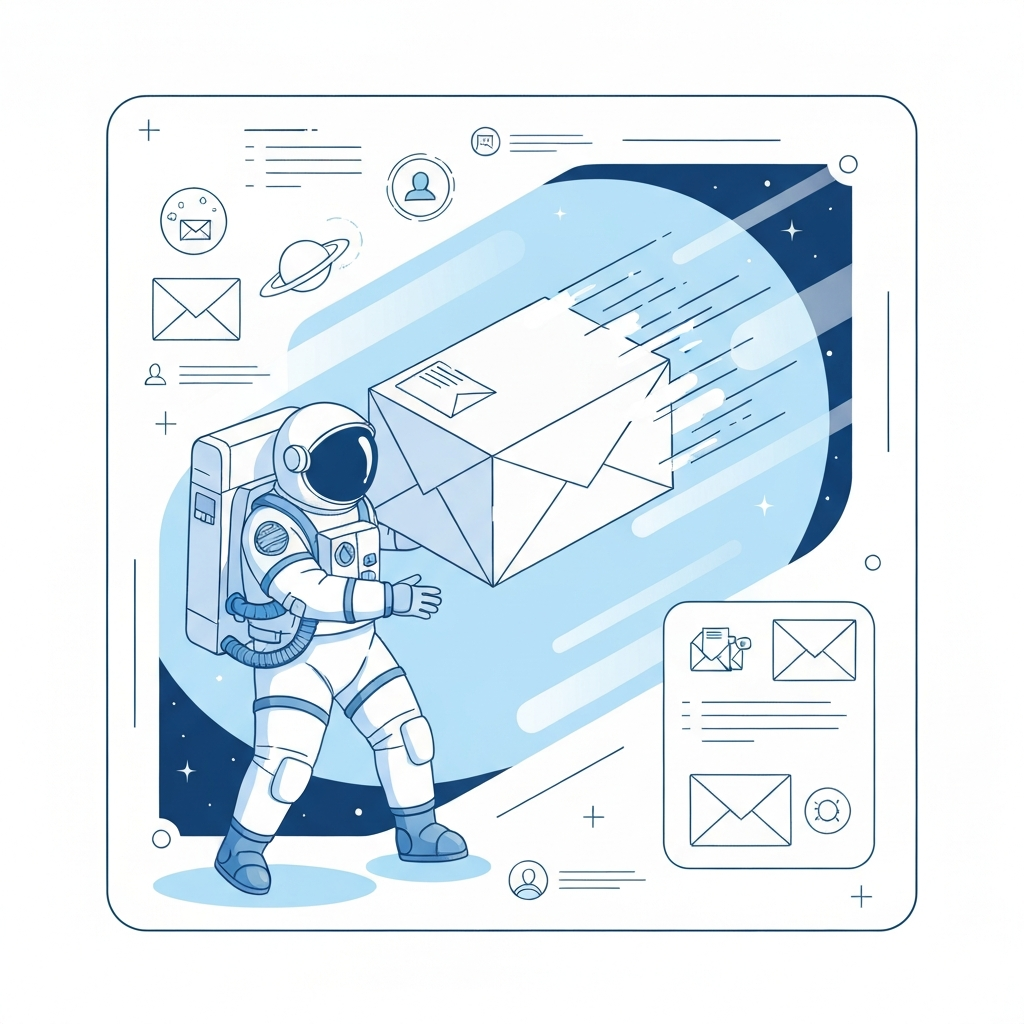Superhuman Mail: Boost Your Inbox Productivity

The modern professional's inbox can feel like a battlefield. Endless streams of messages, urgent requests, marketing pitches, and internal communications bombard us daily, often leaving us feeling overwhelmed, reactive, and far from productive. What if you could transcend this chaos? What if you could process your email with astonishing speed and accuracy, reclaiming hours of your week and focusing on what truly matters? This is the promise of superhuman mail – a state of email mastery where your inbox works for you, not against you.
The concept of "superhuman mail" isn't just a catchy phrase; it represents a paradigm shift in how we interact with our digital communications. It's about moving beyond simply managing emails to actively conquering them, transforming a potential time sink into a powerful tool for productivity and strategic advantage. While tools like the Superhuman app have highlighted this aspiration with their premium, speed-focused interface, the underlying principle – achieving peak email efficiency – is now more accessible than ever, thanks to the advancements in Artificial Intelligence.
In this comprehensive guide, we'll explore what it truly means to achieve superhuman mail status, delve into the common pain points that plague professionals, and reveal how AI-powered solutions are the key to unlocking this elevated level of email productivity. Get ready to discover how to reduce email overload, implement smart email management techniques, and finally gain control over your digital communication.
The Modern Inbox Crisis: Common Email Pain Points for Professionals
If your inbox feels like a black hole, you're not alone. The sheer volume and complexity of email communication have created a crisis for many professionals across industries. Statistics consistently show that individuals spend a significant portion of their workday buried in their inboxes. For instance, studies suggest the average professional spends upwards of 3 hours per day on email, a figure that can easily climb higher for those in demanding roles.
Let's break down the common challenges faced by busy professionals:
- Overwhelming Volume: For executives, entrepreneurs, and team leads, the inbox is often a central hub for critical decisions, client communication, and team coordination. This leads to an avalanche of messages that are difficult to sort through.
- Lost Important Messages: With hundreds or thousands of emails arriving weekly, critical messages can easily get buried, leading to missed deadlines, lost opportunities, or miscommunications. This is particularly true for sales professionals who rely on timely follow-ups.
- Time Wasted on Routine Tasks: Much of our email time is spent on repetitive actions: filing, categorizing, drafting standard replies, scheduling meetings, or searching for information. These tasks, while necessary, detract from high-value strategic work.
- Information Overload and Context Switching: Long email threads can be challenging to digest quickly. Constantly switching between reading emails, responding, and then returning to other tasks leads to cognitive fatigue and reduced overall efficiency.
- Difficulty Prioritizing: It's not always easy to distinguish between an urgent, critical message and a less important one, leading to reactive work habits rather than proactive task management.
These issues contribute directly to email overload and can significantly hinder productivity. While traditional email productivity hacks like "batching" or "unsubscribing" are helpful, they often aren't enough to combat the sheer scale of the problem. This is where a more advanced approach, powered by cutting-edge technology, becomes essential. Understanding these pain points is the first step toward finding a solution that can truly help you manage email overload and achieve a more streamlined workflow. If you're struggling with this, you might find our guide on how to manage email overload: conquer your inbox with AI particularly insightful.
Leveraging AI: The Core of Achieving Superhuman Email Speed
The dream of superhuman mail is now within reach because Artificial Intelligence has evolved beyond simple automation. AI, particularly through advanced machine learning and natural language processing (NLP), can understand, interpret, and act upon the nuances of human communication in ways previously unimaginable. It's not just about doing tasks faster; it's about doing them smarter.
An AI email assistant acts as your intelligent co-pilot, capable of handling the complexities of your inbox with remarkable efficiency. Here's why AI is the game-changer:
- Pattern Recognition: AI can learn your communication patterns, identify important contacts, understand the urgency of different topics, and predict your likely actions, all of which contribute to smart email management.
- Natural Language Understanding (NLU): AI can "read" and comprehend the content of your emails, extracting key information like action items, deadlines, meeting requests, and sentiment.
- Predictive Capabilities: Based on historical data and context, AI can anticipate needs, suggest optimal responses, and even identify potential issues before they arise.
- Scalability: AI can process thousands of emails simultaneously without fatigue, offering a level of throughput that no human can match.
- Continuous Learning: As you use AI tools, they become more personalized and effective, constantly refining their understanding of your preferences and priorities.
By leveraging AI, you move from a reactive approach to a proactive one. Instead of sifting through messages, AI can pre-sort, prioritize, and even draft responses, significantly accelerating your faster email processing capabilities. This allows you to dedicate your mental energy to higher-level thinking and strategic execution, rather than getting bogged down in the minutiae of your inbox.
Key AI Features for Superhuman Email Management
The true power of AI in transforming your inbox lies in its specific capabilities. Modern AI-driven tools offer a suite of features designed to tackle the most time-consuming aspects of email management. Let's explore some of the most impactful:
Smart Sorting and Prioritization
Tired of missing urgent messages? AI can analyze incoming emails based on sender, keywords, previous interactions, and even the sentiment of the message to automatically categorize and prioritize them. This means your most critical communications rise to the top, allowing you to address them first and reduce the anxiety of overlooking something important. AI can create custom filters and smart folders that go far beyond traditional rule-based systems, ensuring that relevant information is always at your fingertips.
Automated Replies and Drafting
Many emails require standard responses or can be addressed with minimal input. AI can draft replies for common inquiries, suggest responses based on the email's content, or even automate scheduling confirmations. For instance, if someone suggests a meeting time, AI can check your calendar and propose available slots, or even send a polite "out of office" style response for less urgent matters. This is a cornerstone of effective email automation tools, freeing up significant time.
Intelligent Summarization
Long email threads can be daunting. AI-powered summarization tools can condense lengthy conversations into concise bullet points, highlighting the key decisions, action items, and main points. This allows you to grasp the essence of a discussion in seconds, rather than minutes or even hours spent reading through numerous replies. This feature is invaluable for staying up-to-date on ongoing projects without getting lost in the details.
Contextual Understanding and Information Extraction
Beyond just keywords, AI can understand the context of your emails. It can identify action items assigned to you, extract contact information, pull out key dates and deadlines, and even understand the tone of a message. This intelligent extraction means that important data is automatically surfaced, reducing the need for manual data entry or searching through multiple messages to find a single piece of information.
Smart Search and Retrieval
Forget struggling with keyword searches that yield too many or too few results. AI enhances search functionality by understanding natural language queries. You can ask questions like "What was the decision made on the Q3 marketing budget last week?" and the AI can sift through your emails to find the relevant answer, even if the exact phrasing isn't present in the email. This dramatically speeds up information retrieval.
These features, when combined, create a powerful system for smart email management. They work in concert to ensure that you're not just responding to emails, but actively managing your communication flow with unprecedented speed and intelligence. As noted in reviews of advanced productivity tools, features like these are designed to help users save hours per week, a testament to their impact.
Actionable Strategies to Reclaim Your Inbox with AI
Implementing AI into your email workflow isn't just about adopting new technology; it's about adopting new habits and strategies that leverage that technology to its fullest potential. Here are actionable steps to help you achieve superhuman mail:
- Embrace AI-Powered Triage: Configure your AI email assistant to automatically sort and flag incoming messages based on urgency, sender importance, or keywords. Dedicate a specific time each day to review only the high-priority items flagged by the AI, while deferring or batching lower-priority messages. This is a foundational email productivity hack.
- Utilize AI for Drafting and Responding: For routine inquiries, use AI to draft responses. Review and send them quickly. For more complex emails, let AI provide a starting point or suggest relevant phrases. This drastically speeds up the writing process and ensures consistency. Explore how an ai virtual assistant can boost your email productivity by handling these tasks.
- Leverage Summaries for Quick Comprehension: Before diving into a long email thread, use the AI summarization feature. This allows you to quickly understand the context, key decisions, and action items without reading every single message. This is a significant time-saver, especially for project updates or client discussions.
- Automate Follow-ups and Reminders: Many AI tools can track whether a response has been received to an email you sent, or remind you to follow up on your own sent items. This ensures that important tasks don't slip through the cracks and helps maintain momentum in your communications.
- Integrate AI with Your Calendar and CRM: For professionals in sales or client-facing roles, integrating your AI email assistant with your calendar and CRM is crucial. AI can automatically log email interactions in your CRM, schedule meetings directly from emails, and update your calendar, creating a seamless flow of information and reducing manual data entry.
- Set Up AI-Powered Notifications Wisely: While AI can help filter, it's also important to configure notifications so you're alerted only to genuinely critical messages. This prevents constant interruptions while ensuring you don't miss urgent communications.
- Regularly Review and Refine AI Settings: AI tools learn and improve over time, but they benefit from periodic human oversight. Review the AI's sorting, prioritization, and suggested responses periodically to ensure they align with your evolving needs and priorities. This continuous feedback loop is key to optimizing your smart email management system.
By adopting these strategies, you're not just using AI; you're actively designing a more efficient and effective email process. This proactive approach is what separates mere inbox management from achieving a truly superhuman mail experience, allowing you to focus your energy on strategic work rather than being consumed by your inbox.
Case Studies/Examples: How Professionals Achieve Superhuman Mail
The impact of AI-powered email management is best understood through real-world (or realistic) scenarios. These examples illustrate how different professionals can transform their daily routines and achieve a state of superhuman mail:
The Overwhelmed Executive
Scenario: Sarah, a CEO, receives hundreds of emails daily, ranging from board communications and investor updates to urgent operational issues and internal team requests. Her inbox was a constant source of stress, and she often felt she was playing catch-up.
AI Solution: Sarah implemented an AI email assistant that automatically categorized emails: "Urgent CEO Action," "Board Updates," "Team Matters," "FYI." It summarized lengthy reports and investor communications into brief digests, highlighting key figures and action points. AI also drafted responses to common administrative inquiries and managed her calendar for meeting requests, presenting her with pre-vetted options.
Result: Sarah saved an estimated 5-7 hours per week. She could now review critical information faster, make decisions more promptly, and spend more time on strategic planning and team leadership, rather than sifting through emails. Her ability to reduce email overload was dramatic.
The High-Volume Sales Professional
Scenario: Mark, a sales director, juggled leads, client communications, proposal follow-ups, and internal reporting. Important leads were sometimes missed, and follow-up cadences were inconsistent due to the sheer volume of daily correspondence.
AI Solution: Mark utilized AI-powered email automation tools. The AI automatically flagged new leads, drafted personalized follow-up emails based on previous interactions, and scheduled reminders for him to call specific prospects. It also summarized client email threads, ensuring he always had the latest context before a call or meeting. AI helped him maintain consistent engagement without manual tracking.
Result: Mark saw a 20% increase in his response rates and a 15% improvement in conversion rates due to more timely and consistent follow-ups. He spent less time on administrative tasks and more time building relationships and closing deals, demonstrating powerful faster email processing and engagement.
The Busy Entrepreneur
Scenario: Emily, founder of a growing startup, was the primary point of contact for investors, partners, customers, and her team. She struggled to balance business development with day-to-day operations, often finding her inbox dictating her schedule.
AI Solution: Emily adopted an AI tool that acted as a sophisticated filter and response generator. It identified urgent customer support issues, summarized partnership proposals, and drafted polite acknowledgments for less critical inbound messages. It also helped her delegate tasks by identifying action items and suggesting them to relevant team members through integrated project management tools.
Result: Emily regained control of her schedule, feeling less reactive and more in command. She could focus on strategic growth initiatives, secure new funding, and effectively manage her growing team, all while ensuring essential communications were handled promptly. She achieved a form of smart email management that supported her entrepreneurial ambitions.
These examples highlight how AI doesn't just offer incremental improvements; it enables a fundamental shift in how professionals interact with their email, leading to significant gains in productivity, efficiency, and overall job satisfaction. The aspiration of superhuman mail becomes a tangible reality.
Choosing the Right AI Email Tool for Your Needs
With the growing popularity of AI in productivity, numerous tools promise to revolutionize your inbox. Selecting the right one depends on your specific needs, workflow, and budget. Here’s a guide to help you navigate the options and find a solution that empowers you to achieve superhuman mail:
Key Features to Look For:
- Smart Sorting & Prioritization: Does it intelligently categorize and flag your most important emails?
- Automated Response Generation: Can it draft replies, suggest responses, or handle routine acknowledgments?
- Email Summarization: Does it offer concise summaries of long threads or documents?
- Integration Capabilities: Does it seamlessly connect with your calendar, CRM, project management tools, or other essential software?
- Natural Language Processing (NLP): How well does it understand the nuances of your emails and your queries?
- Customization & Learning: Can you train the AI to better understand your priorities and preferences?
- Security & Privacy: Is your data protected? What are the tool's data handling policies?
- User Interface (UI) & User Experience (UX): Is the tool intuitive and easy to use?
Types of AI Email Solutions:
- Dedicated AI Email Assistants: These are specialized tools focused solely on enhancing email productivity, often offering advanced features like smart sorting, auto-drafting, and summarization.
- AI-Powered CRMs: Many Customer Relationship Management systems now incorporate AI features to help sales and service teams manage client communications more efficiently.
- General AI Productivity Platforms: Some broader AI assistants can be configured to manage email tasks, often integrating with existing email clients.
When evaluating your options, consider tools that offer comprehensive support. For professionals seeking advanced capabilities, an ai executive assistant can be a game-changer, offering sophisticated email management, scheduling, and task delegation features designed to free up your valuable time. Tools like these are specifically built to handle the complex communication demands of busy executives and professionals, providing a high level of automation and intelligence.
It's also beneficial to consider specialized tools. If you're looking for the absolute best AI assistant for email productivity, research options that align with your primary pain points. Some platforms excel at drafting, while others are masters of organization and summarization. Reading reviews, like those available for tools such as the Superhuman app, can offer insights into what makes an email client truly productive, though the underlying AI capabilities are now found in a wider range of solutions.
Don't be afraid to try out free trials or freemium versions of tools to see how they fit into your workflow. The goal is to find a solution that genuinely helps you reduce email overload and achieve smart email management, rather than adding another layer of complexity.
Conclusion: Your Path to a Superhuman Inbox
The dream of superhuman mail is no longer an unattainable fantasy reserved for a select few. It's a tangible goal, made possible by the rapid advancements in Artificial Intelligence. We've seen how the modern inbox crisis, characterized by overwhelming volumes and critical message loss, can be effectively tackled with the right approach.
By leveraging AI-powered features such as smart sorting, automated replies, and intelligent summarization, professionals can dramatically accelerate their faster email processing capabilities. Implementing actionable strategies—from AI-driven triage to integrated workflow tools—allows you to move from a reactive state of email management to a proactive, controlled, and highly efficient system.
Whether you're an executive drowning in communications, a sales professional aiming for higher engagement, or an entrepreneur scaling your business, AI offers the tools to reclaim your time, sharpen your focus, and elevate your productivity. Embracing an AI email assistant is not just about managing emails better; it's about unlocking your potential to focus on high-value work that drives growth and innovation.
Your journey to a superhuman mail inbox begins with understanding the challenges and exploring the AI-powered solutions available. Take the first step today: evaluate your current email habits, identify your biggest pain points, and start exploring the AI tools that can help you conquer your inbox and achieve peak productivity. The future of email management is intelligent, efficient, and within your reach.
```


